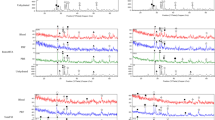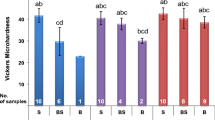Abstract
Objective
The objective of this study was to analyze the microstructure and crystalline structures of ProRoot MTA, Biodentine, CEM Cement, and Retro MTA when exposed to phosphate-buffered saline, butyric acid, and blood.
Methods and materials
Mixed samples of ProRoot MTA, Biodentine, CEM Cement, and Retro MTA were exposed to either phosphate-buffered saline, butyric acid, or blood. Scanning electron microscope (SEM) and energy-dispersive X-ray spectroscopic (EDX) evaluations were conducted of specimens. X-ray diffraction (XRD) analysis was also performed for both hydrated and powder forms of evaluated calcium silicate cements.
Results
The peak of tricalcium silicate and dicalcium silicate detected in all hydrated cements was smaller than that seen in their unhydrated powders. The peak of calcium hydroxide (Ca(OH)2) in blood- and acid-exposed ProRoot MTA, CEM Cement, and Retro MTA specimens were smaller than that of specimens exposed to PBS. The peak of Ca(OH)2 seen in Biodentine™ specimens exposed to blood was similar to that of PBS-exposed specimens. On the other hand, those exposed to acid exhibited smaller peaks of Ca(OH)2.
Conclusion
Exposure to blood or acidic pH decreased Ca(OH)2 crystalline formation in ProRoot MTA, CEM Cement and Retro MTA. However, a decrease in Ca(OH)2 was only seen when Biodentine™ exposed to acid.
Clinical relevance
The formation of Ca(OH)2 which influences the biological properties of calcium silicate cements was impaired by blood and acid exposures in ProRoot MTA, CEM Cement, and Retro MTA; however, in the case of Biodentine, only exposure to acid had this detrimental effect.





Similar content being viewed by others
References
Nekoofar MH, Davies TE, Stone D, Basturk FB, Dummer PM (2011) Microstructure and chemical analysis of blood-contaminated mineral trioxide aggregate. Int Endod J 44:1011–1018. https://doi.org/10.1111/j.1365-2591.2011.01909.x
Marconyak LJ Jr, Kirkpatrick TC, Roberts HW, Roberts MD, Aparicio A, Himel VT, Sabey KA (2016) A comparison of coronal tooth discoloration elicited by various endodontic reparative materials. J Endod 42(3):470–473. https://doi.org/10.1016/j.joen.2015.10.013
Kohli MR, Yamaguchi M, Setzer FC, Karabucak B (2015) Spectrophotometric analysis of coronal tooth discoloration induced by various bioceramic cements and other endodontic materials. J Endod 41(11):1862–1866. https://doi.org/10.1016/j.joen.2015.07.003
Nosrat A, Nekoofar MH, Bolhari B, Dummer PM (2012) Unintentional extrusion of mineral trioxide aggregate: a report of three cases. Int Endod J 45(12):1165–1176. https://doi.org/10.1111/j.1365-2591.2012.02082.x
Bakhtiar H, Nekoofar MH, Aminishakib P, Abedi F, Naghi Moosavi F, Esnaashari E, Azizi A, Esmailian S, Ellini MR, Mesgarzadeh V, Sezavar M, About I (2017) Human pulp responses to partial pulpotomy treatment with TheraCal as compared with Biodentine and ProRoot MTA: a clinical trial. J Endod 43:1786–1791. https://doi.org/10.1016/j.joen.2017.06.025
Butt N, Talwar S, Chaudhry S, Nawal RR, Yadav S, Bali A (2014) Comparison of physical and mechanical properties of mineral trioxide aggregate and Biodentine. Indian J Dent Res 25(6):692–697. https://doi.org/10.4103/0970-9290.152163
Kim JR, Nosrat A, Fouad AF (2015) Interfacial characteristics of Biodentine and MTA with dentine in simulated body fluid. J Dent 43(2):241–247. https://doi.org/10.1016/j.jdent.2014.11.004
Setbon HM, Devaux J, Iserentant A, Leloup G, Leprince JG (2014) Influence of composition on setting kinetics of new injectable and/or fast setting tricalcium silicate cements. Dent Mater 30(12):1291–1303. https://doi.org/10.1016/j.dental.2014.09.005
Camilleri J, Laurent P, About I (2014) Hydration of Biodentine, Theracal LC, and a prototype tricalcium silicate-based dentin replacement material after pulp capping in entire tooth cultures. J Endod 40(11):1846–1854. https://doi.org/10.1016/j.joen.2014.06.018
Esmaeili B, Alaghehmand H, Kordafshari T, Daryakenari G, Ehsani M, Bijani A (2016) Coronal discoloration induced by calcium-enriched mixture, mineral trioxide aggregate and calcium hydroxide: a spectrophotometric analysis. Iran Endod J 11(1):23–28. https://doi.org/10.7508/iej.2016.01.005
Shokouhinejad N, Nekoofar MH, Pirmoazen S, Shamshiri AR, Dummer PM (2016) Evaluation and comparison of occurrence of tooth discoloration after the application of various calcium silicate-based cements: an ex vivo study. J Endod 42(1):140–144. https://doi.org/10.1016/j.joen.2015.08.034
Rouhani A, Akbari M, Farhadi-Faz A (2016) Comparison of tooth discoloration induced by calcium-enriched mixture and mineral trioxide aggregate. Iran Endod J 11(3):175–178. https://doi.org/10.7508/iej.2016.03.005
Utneja S, Nawal RR, Talwar S, Verma M (2015) Current perspectives of bio-ceramic technology in endodontics: calcium enriched mixture cement—review of its composition, properties and applications. Restor Dent Endod 40(1):1–13. https://doi.org/10.5395/rde.2015.40.1.1
Kang SH, Shin YS, Lee HS, Kim SO, Shin Y, Jung IY, Song JS (2015) Color changes of teeth after treatment with various mineral trioxide aggregate-based materials: an ex vivo study. J Endod 41(5):737–741. https://doi.org/10.1016/j.joen.2015.01.019
Ha WN, Bentz DP, Kahler B, Walsh LJ (2015) D90: the strongest contributor to setting time in mineral trioxide aggregate and Portland cement. J Endod 41(7):1146–1150. https://doi.org/10.1016/j.joen.2015.02.033
Malkondu O, Karapinar Kazandag M, Kazazoglu E (2014) A review on biodentine, a contemporary dentine replacement and repair material. Biomed Res Int 2014:160951. https://doi.org/10.1155/2014/160951 10
Bakhtiar H, Mirzaei H, Bagheri MR, Fani N, Mashhadiabbas F, Baghaban Eslaminejad M, Sharifi D, Nekoofar MH, Dummer P (2017) Histologic tissue response to furcation perforation repair using mineral trioxide aggregate or dental pulp stem cells loaded onto treated dentin matrix or tricalcium phosphate. Clin Oral Investig 21:1579–1588. https://doi.org/10.1007/s00784-016-1967-0
Nekoofar MH, Stone DF, Dummer PM (2010) The effect of blood contamination on the compressive strength and surface microstructure of mineral trioxide aggregate. Int Endod J 43(9):782–791. https://doi.org/10.1111/j.1365-2591.2010.01745.x
Bolhari B, Nekoofar MH, Sharifian M, Ghabrai S, Meraji N, Dummer PM (2014) Acid and microhardness of mineral trioxide aggregate and mineral trioxide aggregate-like materials. J Endod 40(3):432–435. https://doi.org/10.1016/j.joen.2013.10.014
Nekoofar MH, Davies TE, Stone D, Basturk FB, Dummer PM (2011) Microstructure and chemical analysis of blood-contaminated mineral trioxide aggregate. Int Endod J 44(11):1011–1018. https://doi.org/10.1111/j.1365-2591.2011.01909.x
Sheykhrezae MS, Meraji N, Ghanbari F, Nekoofar MH, Bolhari B, Dummer PMH (2017) Effect of blood contamination on the compressive strength of three calcium silicate-based cements. Aust Endod J. https://doi.org/10.1111/aej.12227
Provenzano JC, Rocas IN, Tavares LF, Neves BC, Siqueira JF Jr (2015) Short-chain fatty acids in infected root canals of teeth with apical periodontitis before and after treatment. J Endod 41(6):831–835. https://doi.org/10.1016/j.joen.2015.02.006
Nekoofar M, Aseeley Z, Dummer P (2010) The effect of various mixing techniques on the surface microhardness of mineral trioxide aggregate. Int Endod J 43(4):312–320
Namazikhah MS, Nekoofar MH, Sheykhrezae MS, Salariyeh S, Hayes SJ, Bryant ST, Mohammadi MM, Dummer PM (2008) The effect of pH on surface hardness and microstructure of mineral trioxide aggregate. Int Endod J 41:108–116. https://doi.org/10.1111/j.1365-2591.2007.01325.x
Marques MR, Loebenberg R, Almukainzi M (2011) Simulated biological fluids with possible application in dissolution testing. Dissolut Technol 18(3):15–28. https://doi.org/10.14227/DT180311P15
Lee YL, Lee BS, Lin FH, Yun Lin A, Lan WH, Lin CP (2004) Effects of physiological environments on the hydration behavior of mineral trioxide aggregate. Biomaterials 25(5):787–793
Grazziotin-Soares R, Nekoofar MH, Davies TE, Bafail A, Alhaddar E, Hubler R, Busato AL, Dummer PM (2014) Effect of bismuth oxide on white mineral trioxide aggregate: chemical characterization and physical properties. Int Endod J 47:520–533. https://doi.org/10.1111/iej.12181
Camilleri J (2010) Hydration characteristics of calcium silicate cements with alternative radiopacifiers used as root-end filling materials. J Endod 36(3):502–508. https://doi.org/10.1016/j.joen.2009.10.018
Basturk FB, Nekoofar MH, Gunday M, Dummer PMH (2017) X-ray diffraction analysis of MTA mixed and placed with various techniques. Clin Oral Investig. https://doi.org/10.1007/s00784-017-2241-9
Camilleri J, Sorrentino F, Damidot D (2013) Investigation of the hydration and bioactivity of radiopacified tricalcium silicate cement, Biodentine and MTA Angelus. Dent Mater 29(5):580–593. https://doi.org/10.1016/j.dental.2013.03.007
Lee YL, Wang WH, Lin FH, Lin CP (2017) Hydration behaviors of calcium silicate-based biomaterials. J Formos Med Assoc 116(6):424–431. https://doi.org/10.1016/j.jfma.2016.07.009
Kayahan MB, Nekoofar MH, McCann A, Sunay H, Kaptan RF, Meraji N, Dummer PM (2013) Effect of acid etching procedures on the compressive strength of 4 calcium silicate-based endodontic cements. J Endod 39:1646–1648. https://doi.org/10.1016/j.joen.2013.09.008
Bolhari B, Ashofteh Yazdi K, Sharifi F, Pirmoazen S (2015) Comparative scanning electron microscopic study of the marginal adaptation of four root-end filling materials in presence and absence of blood. J Dent (Tehran) 12(3):226–234
Grech L, Mallia B, Camilleri J (2013) Characterization of set intermediate restorative material, biodentine, bioaggregate and a prototype calcium silicate cement for use as root-end filling materials. Int Endod J 46(7):632–641. https://doi.org/10.1111/iej.12039
Formosa LM, Mallia B, Camilleri J (2012) The effect of curing conditions on the physical properties of tricalcium silicate cement for use as a dental biomaterial. Int Endod J 45(4):326–336. https://doi.org/10.1111/j.1365-2591.2011.01980.x
Grazziotin-Soares R, Nekoofar MH, Davies T, Hubler R, Meraji N, Dummer PMH (2017) Crystalline phases involved in the hydration of calcium silicate-based cements: semi-quantitative Rietveld X-ray diffraction analysis. Aust Endod J. https://doi.org/10.1111/aej.12226
De-Deus G, Canabarro A, Alves G, Linhares A, Senne MI, Granjeiro JM (2009) Optimal cytocompatibility of a bioceramic nanoparticulate cement in primary human mesenchymal cells. J Endod 35(10):1387–1390. https://doi.org/10.1016/j.joen.2009.06.022
Forbes WF, Gentleman JF (1998) Risk factors, causality, and policy initiatives: the case of aluminum and mental impairment. Exp Gerontol 33(1–2):141–154
Camilleri J, Kralj P, Veber M, Sinagra E (2012) Characterization and analyses of acid-extractable and leached trace elements in dental cements. Int Endod J 45(8):737–743. https://doi.org/10.1111/j.1365-2591.2012.02027.x
Basturk FB, Nekoofar MH, Gunday M, Dummer PM (2014) Effect of various mixing and placement techniques on the flexural strength and porosity of mineral trioxide aggregate. J Endod 40:441–445. https://doi.org/10.1016/j.joen.2013.08.010
Funding
The work was supported by Tehran University of Medical Sciences, Tehran, Iran (grant no. 27183).
Author information
Authors and Affiliations
Corresponding authors
Ethics declarations
Conflict of interest
The authors declare that they have no conflict of interest.
Ethical approval
This article does not contain any studies with human participants or animals performed by any of the authors.
Informed consent
For this type of study, formal consent is not required.
Electronic supplementary material
ESM 1
(PDF 158 kb)
Rights and permissions
About this article
Cite this article
Ashofteh Yazdi, K., Ghabraei, S., Bolhari, B. et al. Microstructure and chemical analysis of four calcium silicate-based cements in different environmental conditions. Clin Oral Invest 23, 43–52 (2019). https://doi.org/10.1007/s00784-018-2394-1
Received:
Accepted:
Published:
Issue Date:
DOI: https://doi.org/10.1007/s00784-018-2394-1




